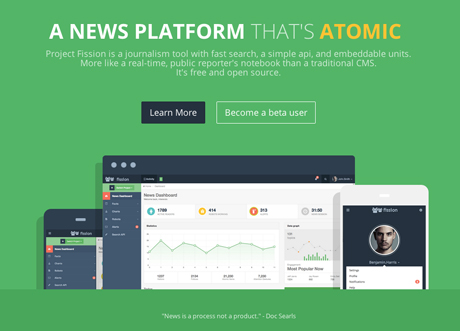
A new project recently funded by the Knight Foundation's Prototype Fund hopes to re-invent the reporter's notebook across multiple devices based on the idea that "news is a process, not a product".
Project Fission, currently under construction by Matt Terenzio, a software developer at Digital First Media, is intended to help journalists rethink how they store and publish information as "an open source tool for journalists to create news in a more data-centric way".
"The common atomic unit of news in most content management systems is based around an article," Terenzio told Journalism.co.uk, a system and understanding "left over from the print era" but with a number of "shortcomings" in how stories develop over time.
"We wanted to explore the idea that maybe there's a better way than the article to store our news for use or re-use," he said, "and maybe new ways of delivering news will spring out of it."
Drawing on the concept of 'structured journalism' – of storing and indexing the information that makes up news stories so it can be better used in future articles – and the idea of atomic units of news central to how Circa delivers stories, Terenzio hopes Project Fission can extend the half-life of news information.
"Before digital, journalists would go and look up stories on microfiche a year later to try to find stories and collect notes," he said, "unless they still had their notebooks and had it indexed well.
"When you store things in largely full text search, which is the best you might be able to get out of your CMS [content management system], you're doing a digital version of microfiche but it's not the same as if you had stored the information initially in a better way."

Screenshot from Fission.io
Through Project Fission, the different atomic elements of a story – facts, quotes, people, places – could be stored, publicly or privately, on desktop, tablet or mobile, for use in later stories.
By storing all relevant information, rather than only that which was published, Terenzio said a journalist could go back through their Fission database to find, for example, all of the quotes from a politician over a certain period of time to be used in a new story.
Figuring out what the specific categories will be is "at the core" of Project Fission, he said, but in the future users should be able to create their own ontology.
"It takes work to make it useful," he said. "A journalist would be likely to put enough information into the reporter's notebook so that later on they would find it useful and understandable.
"So with this system, they have to put in enough information so that later on they – or another journalist or a reader or a search engine – would find that information useful. It takes more overhead in the beginning but the pay-off is huge down the line."I think we're in the golden age of journalismMatt Terenzio, Project Fission
Terenzio suggested a journalist could present the information in a story but also point to their Fission database to let readers or other journalists see the bare facts and draw their own conclusions. Further down the line, it could be used to quickly collect all the information around a public figure or calendar event, for obituaries or anniversaries, he said, although much of the functionality is still conceptual.
One use he envisions is in "versioning", whereby any changes made to published facts or quotes would be recorded and made publicly available for reference.
Geolocation and time stamps could also play an important role in both identifying and verifying pieces of information, while an analytics system could tell journalists whether readers believe publicly available information not used in a story is important.
Although Fission is based on bite-sized chunks of information that have become a theme of the modern, digital, rolling news cycle, Terenzio believes that long-form journalism is still an integral part of the media. As such, the two styles of presenting stories should be complementary rather than mutually exclusive.
"I think we're in the golden age of journalism," he said, "where both of those areas are going to be exploding. One where you have the factual pieces, and people need access to those in ways that they couldn't before, and in another way where it's more important than ever that you have a long narrative."You can install it without an IT department, that's my goalMatt Terenzio, Project Fission
By the summer, he hopes to have a working database that is solid enough to let other developers begin to build their own software on top, in a similar way to third-party Twitter apps, but the end goal is for simplicity.
"In the beginning it's going to be rough but hopefully after the six months this is something that someone with modest technical skills could take and install a version of to use for their projects," he said. "You can install it without an IT department, that's my goal."
Free daily newsletter
If you like our news and feature articles, you can sign up to receive our free daily (Mon-Fri) email newsletter (mobile friendly).









